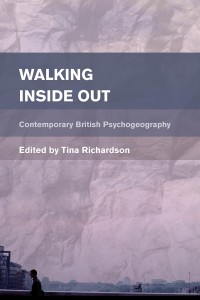WORDS: Tina Richardson
In September 2015 Walking Inside Out: Contemporary British Psychogeography will be released by Rowman and Littlefield International. Edited by myself, contributions are from academics and researchers, and those working in the area of urban walking.
One section of the book in particular looks at memory, historicity and time…
Our relationship with the city is intrinsically tied up with our knowledge and memory of it. If a particular city is somewhere we know – from today or from our past – we are unable to separate our psychological responses to it from the materiality of the place itself.
This, in fact, is psychogeography and is what makes us all psychogeographers to a degree. A sense of place connects us to a geographic region in a specific way that becomes apparent when we start to explore the emotions attached to particular urban pockets that spark something in us. It might be a memory from our adolescence, such as an independent record shop in our hometown where we purchased our first piece of vinyl, or a more recent memory we have of the experience of moving to a new town or city and the differing aesthetics of that place compared to our last home.
These memories are not separate from our self, they inform and form us. The experience of the everyday that is played out in space – walking to the train station, going to the supermarket, taking the dog for a walk – make up a significant part of our day. These practices are imprinted on our psyches over time, forming our relationship with space and at the same time are laid down in our memory of that place, creating our attachment to it.
 What is particularly pertinent to our memory of place is that it is subjective and partial – it cannot be anything other. It is this that lends itself to the multifarious and often contradictory accounts of specific spaces.
What is particularly pertinent to our memory of place is that it is subjective and partial – it cannot be anything other. It is this that lends itself to the multifarious and often contradictory accounts of specific spaces.
In this section of my book, contributions by Alastair Bonnett, Phil Wood, Merlin Coverley and Gareth E. Rees range from qualitative research on memory and place, to personal accounts which interweave fact and fiction. They express how the effects of time and memory become part of our own histories.
You can pre-order Walking Inside Out here
 Tina Richardson is a guest lecturer and writer in the field of urban cultural studies. Specialising in psychogeography she has developed her own methodology called schizocartography. She has had a number of articles published, including in the Spaces and Flows journal and the Society of Cartographers Bulletin. Tina has featured on a BBC Radio 4 programme and also in the British press in regards to a psychogeographical talk she presented on the musician Nick Drake. Tina also ran Leeds Psychogeography Group from 2009-2013.
Tina Richardson is a guest lecturer and writer in the field of urban cultural studies. Specialising in psychogeography she has developed her own methodology called schizocartography. She has had a number of articles published, including in the Spaces and Flows journal and the Society of Cartographers Bulletin. Tina has featured on a BBC Radio 4 programme and also in the British press in regards to a psychogeographical talk she presented on the musician Nick Drake. Tina also ran Leeds Psychogeography Group from 2009-2013.








